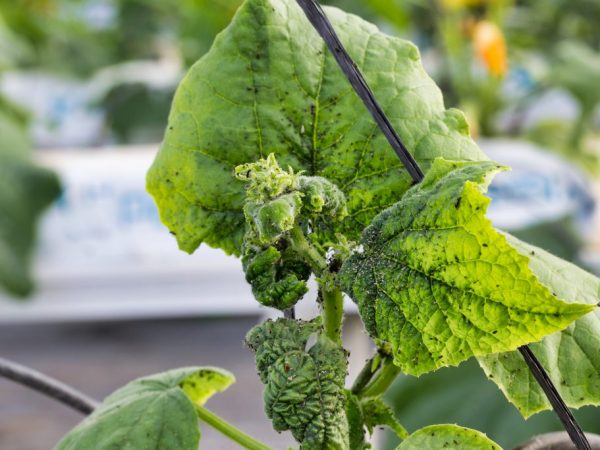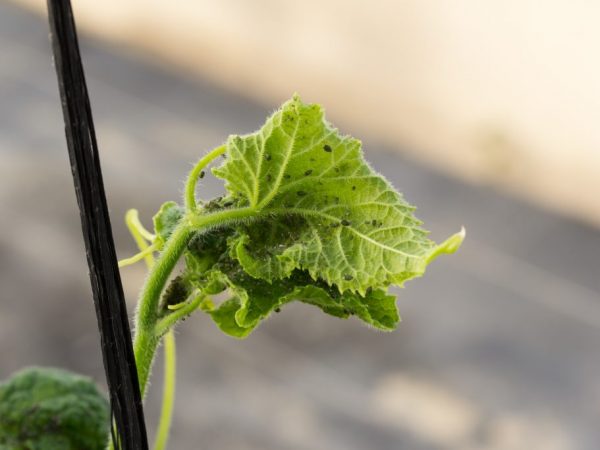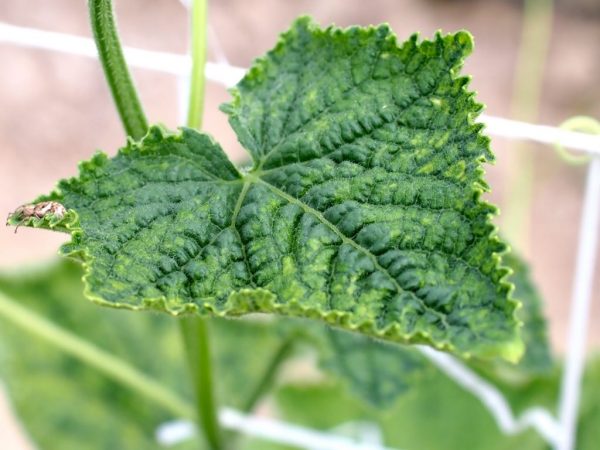How to deal with aphids on cucumbers in a greenhouse
Aphids on cucumbers in a greenhouse are common in horticulture. These small, fast-breeding insects suck the sap from the plant and spread infectious diseases.

Fighting aphids on cucumbers in a greenhouse
Under the influence of aphids, the leaves on the cucumbers turn white, yellow and curl. Vegetable crops cease to grow, bloom and bear fruit. Insects secrete sugar juice, due to which other pests appear on the plant, but thanks to some methods, aphids can be controlled.
Prophylaxis
To prevent aphids from appearing on cucumbers in the greenhouse, they need to be provided with proper care. For this purpose, agrotechnical measures are carried out:
- Watering is carried out with warm water (at least 22 ° C). If the air temperature becomes lower, the number of waterings must also be reduced.
- The seeds are treated with a manganese solution. The grains are kept in it for 15-20 minutes, no more.
- The soil is treated with caustic soda or bleach. You can use a sulfur stick to scare off parasites.
- Once a week, each plant is carefully examined: this way you can quickly see aphids even at the initial stage.
- Provides natural ventilation inside the greenhouse.
- Fertilize the soil regularly.
If aphids are detected at an early stage, the problem can be quickly eliminated. The main thing is to stop the breeding process.
Use of insects and birds
Effective control of aphids on cucumbers in the greenhouse is carried out with the help of insects and birds.
ladybugs
Gardeners recommend planting mustard and dill next to cucumbers. These plants repel pests and are the main food for ladybugs. 1 ladybug can kill up to 50 aphids. In the larval stage, it removes up to 800 parasitic organisms.
Hover flies
They are attracted by the umbrella plants: fennel and parsley. As larvae, they eat only small aphids. As adults, they are able to eliminate parasites of any size. In 2-3 weeks, they are able to suck up to 500 aphids.
Birds
Sparrows, tits help to get rid of aphids quickly enough. To attract them, birdhouses with grain are built and installed inside the greenhouse. It is important not to keep them indoors for too long (more than a week).
Chemical treatment
This method of struggle is used in extreme cases: when the number of parasites is too large and there is a real threat of death of cucumbers. The most harmless agent is phosphorus-potassium fertilizer. It is made on the basis of ingredients:
- 20 g superphosphate;
- 10 g sodium chloride;
- 1 bucket of warm water
On the basis of the resulting liquid, foliar feeding of cucumbers is carried out. The mixture is sprayed on the leaves from below. The treatment is repeated after a week and until the ants and aphid larvae are completely gone.
It is permissible to use means that do not destroy aphids, but infect it with various diseases. Aphids die after a week.
Often, gardeners are afraid to fight against aphids with chemicals that are harmful to the human body.But preparations have already been created, after which the vegetable culture remains environmentally friendly:
- Ethnobacterin;
- Arrow;
- Fitoverm;
- Peretrum;
- Akarin.
Do not apply the product to all plants at once. First, it is advisable to test it on 2-4 bushes to check the reaction of insects. Chemical processing is stopped a month before harvesting.
Traditional methods
Folk methods are more accessible and less expensive. There are many recipes for fixing aphid problems.

You can do without the use of chemicals
If the gardener flatly refuses to use chemicals, you can fight aphids without them. For instance:
- wash the windows with mil solution inside and outside the greenhouse;
- remove 5 cm of the top layer of soil from the garden;
- plant marigolds, mint, cilantro, mustard, which scare away aphids.
You can plant plants that love pests: dill, beans, sow thistle. They will lose interest in cucumbers and switch to them.
Spraying with ash and soap
To create a product, you will need 100 g of laundry soap diluted in 10 liters of warm water.
There are other recipes:
- 300 g of tar soap is mixed with a bucket of water.
- 125 ml of liquid soap is mixed with 10 liters of warm water.
- 300 g of ash is boiled in a bucket of water for about half an hour. Add 40 g of grated soap if desired or use a pure ash solution.
Laundry soap should be coarsely grated. In solutions where both soap and ash are involved, the first component is first waiting for the dissolution of the first component.
All vegetable crops in the greenhouse are sprayed with an ash-and-soap solution.
Herbal infusions
In large quantities, they cause burns on the leaves of cucumbers, they are dangerous not only for aphids, but also for other pests. If you do not follow the recipe, they are poisonous to humans.
Onion
Take 25-30 g of onion heads, cut into small particles. It is permissible to add onion skins. Soak the ingredients in 1 liter of water for 5-7 hours.
Add no more than 5 g of laundry soap. After 7 hours, the infusion is filtered and used.
Chamomile
You will need 100 g of dried grass and 100 g of chamomile inflorescences. They need to be instructed in 1-2 liters of water for 12 hours. For spraying, you need to mix 1/3 of the solution with 3 liters of warm water, add 10 g of grated laundry soap.
Another recipe is to grind 250 g of Caucasian chamomile flowers into powder, dilute the mixture in water. Use immediately after preparation.
Dandelions
400 g of fresh roots and 600 g of leaves need to be finely ground, then pour 10 liters of warm, slightly warmed up water. Insist for at least 3-4 hours.
Coniferous

There are many herbal infusions for pest control
1 kg of pine needles is mixed in 4 liters of water, infused for a week, stirring daily. Spraying is carried out in a 1: 1 ratio.
Tobacco
200 g of crushed tobacco leaves in dried form are placed in a container with 5 liters of water, left to infuse for 2 days.
After 48 hours, bring to a boil in 10 l of water. Be sure to filter.
Garlic
500 garlic is finely chopped, placed in a 3-liter jar and covered with water. The tincture is kept for 5 days.
60 g of the solution is mixed with 10 l of water. Sprayers are used for spraying.
Another remedy is made on the basis of garlic husks:
- 150-160 g of husks are poured into 10 liters of warm water.
- Withstand a day, it is allowed to boil slightly.
- Use immediately. It is undesirable to boil again.
Marigold
Half a bucket (about 5 liters) of dried flowers is poured into 4.5 liters of water, left to infuse for 48 hours, 40 g of tar soap is added. Strain before use.
Pepper
Mix 1 kg of hot red pepper pods or 300 g dry and insist in 10 liters of water.
The solution and water are taken in a ratio of 1:10. Only cucumber leaves are watered.
Potato
You need 1 kg of potato skins, dry - 0.8 kg. They are finely chopped and soaked in 9-11 liters of water. The infusion time is 3-5 hours.
Conclusion
It is quite possible to get rid of aphids on cucumbers in a greenhouse.First you need to adhere to preventive measures: regularly wash the windows, ventilate the room, loosen and fertilize the soil. A good option is to attract beneficial insects and birds, or use other methods of control without chemistry.
If there are too many aphids, chemical spraying will help. If the gardener has discovered pests at the initial stage, it is recommended to use alternative methods. Chamomile, potato, marigold and other infusions will be effective.


